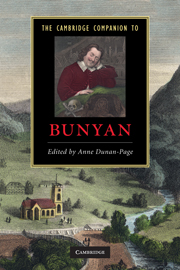Book contents
- Frontmatter
- Introduction
- Part I John Bunyan in his seventeenth-century context
- Part II John Bunyan’s major works
- 5 Grace Abounding to the Chief of Sinners: John Bunyan and spiritual autobiography
- 6 The Pilgrim’s Progress and the line of allegory
- 7 Bunyan and the early novel: The Life and Death of Mr Badman
- 8 Militant religion and politics in The Holy War
- 9 A Book for Boys and Girls: Or, Country Rhimes for Children: Bunyan and literature for children
- Part III Readership and reception
- Guide to further reading
- Index
9 - A Book for Boys and Girls: Or, Country Rhimes for Children: Bunyan and literature for children
from Part II - John Bunyan’s major works
Published online by Cambridge University Press: 28 July 2010
- Frontmatter
- Introduction
- Part I John Bunyan in his seventeenth-century context
- Part II John Bunyan’s major works
- 5 Grace Abounding to the Chief of Sinners: John Bunyan and spiritual autobiography
- 6 The Pilgrim’s Progress and the line of allegory
- 7 Bunyan and the early novel: The Life and Death of Mr Badman
- 8 Militant religion and politics in The Holy War
- 9 A Book for Boys and Girls: Or, Country Rhimes for Children: Bunyan and literature for children
- Part III Readership and reception
- Guide to further reading
- Index
Summary
John Bunyan's work has had a profound and complex influence on the history of children's literature in English, but not in the way he might have expected. For over two centuries, The Pilgrim's Progress was essential reading not in the university classroom but in the nursery, adopted by children who, like Louisa May Alcott's Jo March in Little Women (1868), revelled in the journey and the adventure of Bunyan's allegory. As a children's book, it was so common that Frances Hodgson Burnett, L. M. Montgomery and Mark Twain could assume a basic knowledge of Christian's journey from the City of Destruction to the Celestial City. Both Montgomery and Twain show their protagonists reading Bunyan, with profoundly different responses. While Emily in Montgomery's Emily of New Moon (1923) is proud to have both read and enjoyed Bunyan's allegory (the only book her devout aunts let her read on Sundays), Huckleberry Finn famously judged that the allegory is 'about a man that left his family, it didn't say why. I read considerable in it now and then. The statements was interesting, but tough.' Frances Hodgson Burnett published her own rewriting - Two Little Pilgrims' Progress (1895) - as the journey of two orphans on their way to the Chicago World's Fair of 1893, and Enid Blyton's The Land of Far Beyond (1942) is 'a kind of new Pilgrim's Progress, in my own words, and with my own quite new ideas'. In novels like Little Women (1868), What Katy Did (1872), The Wonderful Wizard of Oz (1900), The Land of Far Beyond and many more, a clever child might detect the characters, concerns, even structural patterns of The Pilgrim's Progress. Running through all of these allusions, revisions and adaptations is the belief that Bunyan's allegory - or some mediated version of it - belongs on each child's bookshelf, becoming one of the most important monuments in the history of children's literature.
- Type
- Chapter
- Information
- The Cambridge Companion to Bunyan , pp. 120 - 134Publisher: Cambridge University PressPrint publication year: 2010
- 2
- Cited by



